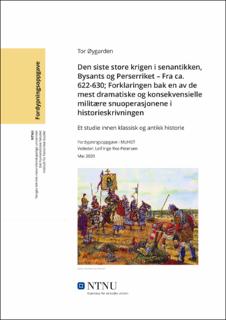| dc.contributor.advisor | Petersen, Leif Inge Ree | |
| dc.contributor.author | Øygarden, Tor | |
| dc.date.accessioned | 2021-09-13T16:01:31Z | |
| dc.date.available | 2021-09-13T16:01:31Z | |
| dc.date.issued | 2020 | |
| dc.identifier | no.ntnu:inspera:57494038:22974606 | |
| dc.identifier.uri | https://hdl.handle.net/11250/2775496 | |
| dc.description.abstract | Den siste store krigen i senantikken som kjempes mellom Bysants og Perserriket, har store ringvirkninger for ettertiden. Teksten har som formål å utforske og forklare hvorfor den siste delen av konflikten utfoldet seg som den gjorde. Et sentralt spørsmål er hvordan bysantinerne kunne snu krigslykken etter den katastrofale begynnelsen av konflikten, der perserne okkuperer store deler av Det bysantinske riket. Fokuset i oppgaven ligger særlig i konfliktens senere år, fra 622-630, da det er denne fasen som er viktigst for å forklare den bysantinske snuoperasjonen. I oppgaven avgrenses forklaringsgrunnlaget til tre ulike faktorer; militære, politiske og geopolitiske. Disse faktorene blir vurdert ut fra deres konsekvens for utviklingen og resultatet av konflikten, i samsvar med historiografien på temaet. Sentrale hendelser, med stor påvirkning for konfliktens gang, presenteres og drøftes også i oppgavens historiografi- og diskusjonsdeler. Selv om de tre ulike faktorene alle dømmes til å ha en stor innvirkning på konfliktens konkluderende fase, er faktorene blitt rangert etter deres påvirkningskraft. De geopolitiske faktorene er anslått å være de viktigste faktorene, tett fulgt av de militære, med de politiske faktorene til sist. Dette valget er tatt på grunnlag av sentrale hendelser, og i lys av historiografisk kontekst. | |
| dc.description.abstract | The last great war of late antiquity, fought between the great powers at the time, Byzantium and Persia, had massive implications for the aftermath. The purpose of this research was to describe why the war unfolded in the way it did, particularly on how a decisive victory in favor of the Byzantines was possible. How could the astonishing reversal of fortunes after the disastrous first part of the war, from being thoroughly stripped of critically important territory, to a conclusive Byzantine victory at the end of the war, be explained? The focus of the text is therefore concentrated on the latter part of the conflict, from 622-630 AD, where the explanation for the rapid Byzantine reconquest lies. The research question of the text is further defined by three key components: military, political and geopolitical explanations. These components are then analyzed separately, and their significance are determined based on their individual impact on the outcome of the war, and in compliance with relevant historiography. Crucial events of the war are also presented and discussed in the historiography and discussion segments of the text. Although all three components has been judged important for explaining the result of the war, a selection of importance was made in following order: The geopolitical explanations are considered the most important, followed closely by the military components and lastly the political factors. The selection was supported by the information gained through historiography and on the record of crucial events. | |
| dc.language | | |
| dc.publisher | NTNU | |
| dc.title | Den siste store krigen i senantikken, Bysants og Perserriket – Fra ca. 622-630; Forklaringen bak en av de mest dramatiske og konsekvensielle militære snuoperasjonene i historieskrivningen | |
| dc.type | Bachelor thesis | |
